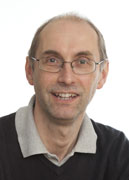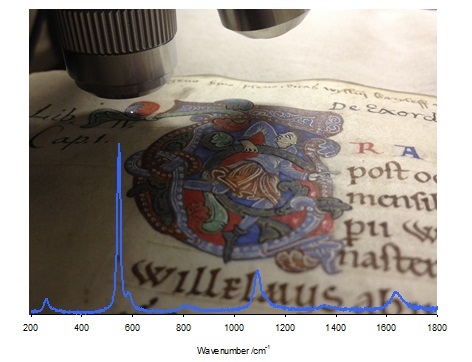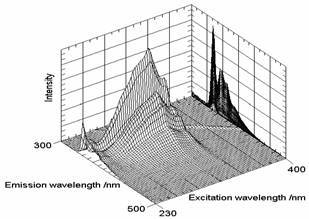Staff profile
Professor Andrew Beeby
Professor

| Affiliation | Telephone |
|---|---|
| Professor in the Department of Chemistry | +44 (0) 191 33 42023 |
| Departmental Rep (Chemistry) in the Institute of Medieval and Early Modern Studies |
Biography
Research Interests
My research interests lie in the fields of photochemistry and photophysics. This work encompasses a wide range of related topics, including the determination of fundamental photophysical parameters, the identification of intermediate species and their kinetic behaviour and the characterisation of a reactions end-products. It is only by having a detailed understanding of all these factors that we can design chemical systems in which we have control over the direction and outcome of photochemical reactions. This comprehensive approach is applied to the study of a number of photo-induced reactions, such as energy transfer, electron transfer and isomerisation. These processes are studied in a range of chemical systems including commercially important materials, e.g. electroluminescent materials, molecular probes containing lanthanide ions, sunscreens, as well as those of more fundamental scientific interest.
The group is well equipped to carry out photophysical measurements. We routinely study samples in both solution and solid states, including homogeneous and inhomogeneous thin films. We can study samples in inert atmospheres and record data over a wide temperature range. In addition to conventional steady-state UV-vis-NIR absorption and fluorescence spectrometers we also have luminescence and Raman imaging microscopes, ns-laser flash photolysis, and fluorescence lifetime spectrometers. We always welcome enquiries from groups that would like to collaborate on any measurements.
Pigments in Medieval Manuscripts
Identifying the materials used in medieval illuminated manuscripts gives us an insight into the techniques and skills of the scribes and illuminators, as well as the sometimes complex trade routes of the times. The challenge is to be able to identify materials on a delicate sheet of parchment, typically a folio of a bound manuscript that does not open readily, without contact, sampling or causing any damage. Ideally the technique should give an unequivocal identification of pigments with high spatial resolution and selectivity: a challenge indeed! At Durham we use Raman spectroscopy combined with hyperspectral imaging and diffuse reflectance spectroscopy to achieve this. Are currently studying the pigments used in manuscripts produced in the British Isles and northern Europe between the 7th and 15th centuries.

The example shown is from Libellus de Exordio atque Procursu istius, hoc est Dunelmensis, Ecclesie (The Little Book on the Origins and Progress of this Church, that is of Durham) written by Symeon ca. 1105, and resides normally at Durham, University Library, Cosin V.II.6. The spectrum below show the presence of lapis lazuli which came from what is now Afghanistan.
Oligoaryleneethynenes
These highly luminescent compounds are currently the subject of intense attention as potential 'molecular wires and switches' and as emissive layers for organic LED's. In collaboration with colleagues at Durham we have been using optical spectroscopies to investigate the role of structure, particularly conformation, upon the emission and material properties of the compounds. We are particularly interested in the electronic structure and bond-order of the ground and excited states and the role of conformation upon these parameters.
Organometallic Complexes as Light Emitting Materials
In the near future it is expected that conventional displays, based upon cathode-ray tubes, will be replaced by new technologies utilising thin-film electroluminecent materials. Devices based upon organic materials rely upon the recombination of holes and electrons that are injected into the material producing excited states, known as excitons, which can be either triplet or singlet character. In conventional materials based upon conjugated polymers only the singlet state excitons can emit light, and triplet excitons, are effectively wasted energy. Our interest lies in the use of organometallic complexes that are capable of harvesting both singlet and triplet excitons to produce light output and includes both the synthesis of new materials and the study of their spectroscopic properties.
The Luminescence of Complexed Lanthanide(III) Ions
We are studying the fundamental photophysical properties of lanthanide ions, including the investigation of the pathways of energy transfer from organic chromophores to the metal ions. Although the properties of terbium and europium have been extensively studied the photophysical behaviour of many other luminescent lanthanide ions in solution have been somewhat neglected for various reasons. We are investigating systems based upon neodymium, ytterbium and erbium in various media and have observed interesting isotope and ligand effects. This work is technically challenging due to the fact that the emission is often very weak, short lived and in the near infra-red spectral region.

Excitation and emission matrix obtained from 1,4-bis(phenylethynyl)benzene in cyclohexane at 298K This spectrum shows that the emission spectrum is independent of the excitation wavelength, indicating that under these conditions the relaxation of excited state conformers occurs very rapidly.2
References
- A. Beeby, K. S. Findlay, P.J. Low, T.B. Marder, P. Matousek, A.W. Parker, S.R. Rutter, M. Towrie, Chem Commun., 2003, 2406.
- A. Beeby, K. Findlay, P.J. Low, T.B. Marder, J. Am. Chem. Soc., 2002, 124, 8280.
- A. Beeby, S.L. Bettington, I.D.W.Samuel and Z.Wang, J. Mater. Chem., 2002, 13, 80.
- A. Beeby, S. Bettington, I.J.S. Fairlamb, A.E. Goeta, A.R. Kapdi, E.H. Niemela and A.L. Thompson, New J. Chem., 2004, 600-605.
- A. Beeby, A.E. Jones, Photochem. Photobiol., 2000, 72, 10.
- A. Beeby, S. FitzGerald and C.F. Stanley, J. Chem. Soc. Perkin Trans. 2., 2001, 1978.
Research interests
- Multispectral imaging
- Photochemistry
- Photophysics
- Pigments of medieval manuscripts
- Spectroscopy
- Time-resolved spectorscopy
Publications
Journal Article
- Escorihuela, E., Del Barrio, J., Davidson, R. J., Beeby, A., Low, P. J., Prez-Murano, F., …Martin, S. (2024). Large area arrays of discrete single-molecule junctions derived from host-guest complexes. Nanoscale, 16(3), 10.1039/d3nr05122f. https://doi.org/10.1039/d3nr05122f
- Chelli, Y., Ferri, N., Vezzoli, A., Davidson, R. J., Morris, J., Nichols, R. J., …Beeby, A. (2023). Connectivity-Dependent Conductance of 2,2′-Bipyridine-Based Metal Complexes. ACS Omega, 8(51), 48958-48965. https://doi.org/10.1021/acsomega.3c06555
- Bara-Estaún, A., Planje, I. J., Almughathawi, R., Naghibi, S., Vezzoli, A., Milan, D. C., …Beeby, A. (2023). Single-Molecule Conductance Behavior of Molecular Bundles. Inorganic Chemistry, 62(51), 20940-20947. https://doi.org/10.1021/acs.inorgchem.3c01943
- Ghigo, T., Occhipinti, M., Beeby, A., Domoney, K., & Bone, D. (2023). Concerns over colour durability in the nineteenth-century industrial revolution: insights from John Ruskin’s teaching collection. Heritage Science, 11(1), Article 168. https://doi.org/10.1186/s40494-023-01010-6
- Qiao, X., Vezzoli, A., Smith, S., Higgins, S. J., Davidson, R. J., Beeby, A., & Nichols, R. J. (2023). Single-Molecule Junction Formation in Deep Eutectic Solvents with Highly Effective Gate Coupling. Journal of Physical Chemistry C, 127(26), 12802-12810. https://doi.org/10.1021/acs.jpcc.3c03129
- Davidson, R., Hsu, Y., Fox, M. A., Aguilar, J. A., Yufit, D., & Beeby, A. (2023). Tuning Emission Lifetimes of Ir(C^N)2(acac) Complexes with Oligo(phenyleneethynylene) Groups. Inorganic Chemistry, 62(6), 2793-2805. https://doi.org/10.1021/acs.inorgchem.2c03934
- Barak, A., Dhiman, N., Sturm, F., Rauch, F., Lakshmanna, Y. A., Findlay, K. S., …Umapathy, S. (2022). Excited‐State Intramolecular Charge‐Transfer Dynamics in 4‐Dimethylamino‐4′‐cyanodiphenylacetylene: An Ultrafast Raman Loss Spectroscopic Perspective. ChemPhotoChem, 6(12), Article e202200146. https://doi.org/10.1002/cptc.202200146
- Ghigo, T., Bone, D., Howell, D., Domoney, K., Gironda, M., & Beeby, A. (2022). Material Characterisation of William Burges’ Great Bookcase within the Disruption of a Global Pandemic. Studies in Conservation, https://doi.org/10.1080/00393630.2022.2153463
- Edkins, R. M., Hsu, Y., Fox, M. A., Yufit, D., Beeby, A., & Davidson, R. J. (2022). Divergent Approach for Tris-Heteroleptic Cyclometalated Iridium Complexes Using Triisopropylsilylethynyl-Substituted Synthons. Organometallics, https://doi.org/10.1021/acs.organomet.2c00292
- Gameson, R., Nicholson, C., & Beeby, A. (2020). The Admiral, the Virgin, and the Spectrometer: Observations on the Coëtivy Hours (Dublin, Chester Beatty Library, W082). Gesta, 59(2), 203-231. https://doi.org/10.1086/710024
- Rozatian, N., Beeby, A., Ashworth, I. W., Sandford, G., & Hodgson, D. R. (2019). Enolization rates control mono- versus di-fluorination of 1,3-dicarbonyl derivatives. Chemical Science, 10(44), 10318-10330. https://doi.org/10.1039/c9sc04185k
- Suhling, K., Hirvonen, L. M., Becker, W., Smietana, S., Netz, H., Milnes, J., …Beeby, A. (2019). Wide-field time-correlated single photon counting-based fluorescence lifetime imaging microscopy. Nuclear Instruments and Methods in Physics Research Section A: Accelerators, Spectrometers, Detectors and Associated Equipment, 942, Article 162365. https://doi.org/10.1016/j.nima.2019.162365
- Davidson, R., Hsu, Y., Griffiths, G. C., Li, C., Yufit, D., Pal, R., & Beeby, A. (2018). Highly Linearized Twisted Iridium(III) Complexes. Inorganic Chemistry, 57(22), 14450-14462. https://doi.org/10.1021/acs.inorgchem.8b02818
- Batsanov, S. S., Osavchuk, A. N., Naumov, S. P., Gavrilkin, S. M., Leskov, A. S., Mendis, B. G., …Batsanov, A. S. (2018). Novel synthesis and properties of hydrogen-free detonation nanodiamond. Materials Chemistry and Physics: Including Materials Science Communications, 216, 120-129. https://doi.org/10.1016/j.matchemphys.2018.05.072
- Davidson, R. J., Milan, D. C., Al-Owaedi, O. A., Ismael, A. K., Nichols, R. J., Higgins, S. J., …Beeby, A. (2018). Conductance of ‘bare-bones’ tripodal molecular wires. RSC Advances, 8(42), 23585-23590. https://doi.org/10.1039/c8ra01257a
- Beeby, A., Garner, L., Howell, D., & Nicholson, C. E. (2018). There’s More to Reflectance Spectroscopy Than Lux. Journal of the Institute of Conservation, 41(2), 142-153. https://doi.org/10.1080/19455224.2018.1463920
- Marucci, G., Beeby, A., Parker, A., & Nicholson, C. (2018). Raman spectroscopic library of medieval pigments collected with five different wavelengths for investigation of illuminated manuscripts. Analytical Methods, 10(10), 1219-1236. https://doi.org/10.1039/c8ay00016f
- Congrave, D. G., Hsu, Y., Batsanov, A. S., Beeby, A., & Bryce, M. R. (2018). Sky-blue emitting bridged diiridium complexes: beneficial effects of intramolecular π–π stacking. Dalton Transactions, 47(6), 2086-2098. https://doi.org/10.1039/c7dt04201a
- Bryden, F., Maruani, A., Rodrigues, J. M., Cheng, M. H., Savoie, H., Beeby, A., …Boyle, R. W. (2018). Assembly of High-Potency Photosensitizer–Antibody Conjugates through Application of Dendron Multiplier Technology. Bioconjugate Chemistry, 29(1), 176-181. https://doi.org/10.1021/acs.bioconjchem.7b00678
- Beeby, A., Gameson, R., & Nicholson, C. (2018). New light on old illuminations. Archives and Records, 39(2), 244-256. https://doi.org/10.1080/23257962.2017.1325729
- Mulholland, R., Howell, D., Beeby, A., Nicholson, C., & Domoney, K. (2017). Identifying eighteenth century pigments at the Bodleian library using in situ Raman spectroscopy, XRF and hyperspectral imaging. Heritage Science, 5(1), Article 43. https://doi.org/10.1186/s40494-017-0157-y
- Davidson, R., Hsu, Y., Bhagani, C., Yufit, D., & Beeby, A. (2017). Exploring the Chemistry and Photophysics of Substituted Picolinates Positional Isomers in Iridium(III) Bisphenylpyridine Complexes. Organometallics, 36(15), 2727-2735. https://doi.org/10.1021/acs.organomet.7b00179
- Roy, K., Kayal, S., Kumar, V. R., Beeby, A., Ariese, F., & Umapathy, S. (2017). Understanding Ultrafast Dynamics of Conformation Specific Photo-Excitation: A Femtosecond Transient Absorption and Ultrafast Raman Loss Study. The Journal of Physical Chemistry A, 121(35), 6538-6546. https://doi.org/10.1021/acs.jpca.7b03893
- Štefančič, A., Klupp, G., Knaflič, T., Yufit, D. S., Tavčar, G., Potočnik, A., …Arčon, D. (2017). Triphenylide-Based Molecular Solid—A New Candidate for a Quantum Spin-Liquid Compound. Journal of Physical Chemistry C, 121(27), 14864-14871. https://doi.org/10.1021/acs.jpcc.7b02763
- Roy, K., Kayal, S., Ariese, F., Beeby, A., & Umapathy, S. (2017). Mode specific excited state dynamics study of bis(phenylethynyl)benzene from ultrafast Raman loss spectroscopy. The Journal of Chemical Physics, 146(6), Article 064303. https://doi.org/10.1063/1.4975174
- Liang, J., Smith, R. E., Vezzoli, A., Xie, L., Milan, D. C., Davidson, R., …Nichols, R. J. (2016). Electrochemically grafted single molecule junctions exploiting a chemical protection strategy. Electrochimica Acta, 220, 436-443. https://doi.org/10.1016/j.electacta.2016.10.095
- Yang, X., Wang, S., King, T. L., Kerr, C. J., Blanchet, C., Svergun, D., …Huang, S. (2016). Anisotropic lanthanide-based nano-clusters for imaging applications. Faraday Discussions, 191, 465-479. https://doi.org/10.1039/c6fd00018e
- Ishida, H., Bünzli, J., & Beeby, A. (2016). Guidelines for measurement of luminescence spectra and quantum yields of inorganic and organometallic compounds in solution and solid state (IUPAC Technical Report). Pure and Applied Chemistry, 88(7), 701-711. https://doi.org/10.1515/pac-2014-0706
- Davidson, R., Hsu, Y., Batchelor, T., Yufit, D., & Beeby, A. (2016). The use of organolithium reagents for the synthesis of 4-aryl-2-phenylpyridines and their corresponding iridium(III)complexes. Dalton Transactions, 45(28), 11496-11507. https://doi.org/10.1039/c6dt01461e
- Beeby, A., Gameson, R., & Nicholson, C. (2016). Illuminators' Pigments in Lancastrian England. Manuscripta, 60(2), 143-164. https://doi.org/10.1484/j.mss.5.111916
- Zhang, W., Gan, S., Vezzoli, A., Davidson, R., Milan, D., Luzyanin, K., …Niu, L. (2016). Single-Molecule Conductance of Viologen–Cucurbit[8]uril Host–Guest Complexes. ACS Nano, 10(5), 5212-5220. https://doi.org/10.1021/acsnano.6b00786
- Gluyas, J., Manici, V., Gückel, S., Vincent, K., Yufit, D., Howard, J., …Low, P. (2015). Cross-Conjugated Systems Based On An (E)-Hexa-3-en-1,5-diyne-3,4-diyl Skeleton: Spectroscopic and Spectroelectrochemical Investigations. Journal of Organic Chemistry, 80(22), 11501-11512. https://doi.org/10.1021/acs.joc.5b02240
- Lavado, A., Chauhan, V., Zen, A., Giuntini, F., Jones, D., Boyle, R., …Aylott, J. (2015). Controlled intracellular generation of reactive oxygen species in human mesenchymal stem cells using porphyrin conjugated nanoparticles. Nanoscale, 7(34), 14525-14531. https://doi.org/10.1039/c5nr00795j
- Davidson, R., Wilson, L., Duckworth, A., Yufit, D., Beeby, A., & Low, P. (2015). Alkyne substituted mononuclear photocatalysts based on [RuCl(bpy)(tpy)](+). Dalton Transactions, 44(25), 11368-11379. https://doi.org/10.1039/c5dt01278c
- Davidson, R., Liang, J., Milan, D., Mao, B., Nichols, R., Higgins, S., …Low, P. (2015). Synthesis, Electrochemistry, and Single-Molecule Conductance of Bimetallic 2,3,5,6-Tetra(pyridine-2-yl)pyrazine-Based Complexes. Inorganic Chemistry, 54(11), 5487-5494. https://doi.org/10.1021/acs.inorgchem.5b00507
- Amara, Z., Bellamy, J., Horvath, R., Miller, S., Beeby, A., Burgard, A., …George, M. (2015). Applying green chemistry to the photochemical route to artemisinin. Nature Chemistry, 7(6), 489-495. https://doi.org/10.1038/nchem.2261
- Stasiuk, G. J., Minuzzi, F., Sae-Heng, M., Rivas, C., Juretschke, H., Piemonti, L., …Long, N. J. (2015). Dual-Modal Magnetic Resonance/Fluorescent Zinc Probes for Pancreatic β-Cell Mass Imaging. Chemistry - A European Journal, 21(13), 5023-5033. https://doi.org/10.1002/chem.201406008
- Hirvonen, L. M., Petrášek, Z., Beeby, A., & Suhling, K. (2015). Sub-μs time resolution in wide-field time-correlated single photon counting microscopy obtained from the photon event phosphor decay. New Journal of Physics, 17(2), https://doi.org/10.1088/1367-2630/17/2/023032
- Gameson, R., Beeby, A., Duckworth, A., & Nicholson, C. (2015). Pigments of the Earliest Northumbrian Manuscripts. Scriptorium (Gent), 69, 33-59
- De Ornellas, S., Slattery, J., Edkins, R., Beeby, A., Baumann, C., & Fairlam, I. (2015). Design and synthesis of fluorescent 7-deazaadenosine nucleosides containing pi-extended diarylacetylene motifs. Organic and Biomolecular Chemistry, 13(1), 68-72. https://doi.org/10.1039/c4ob02081b
- Edkins, R., Probert, M., Robertson, C., Howard, J., Beeby, A., & Robertson, C. (2014). Photocrystallisation of the 2C-2'C dimer of a triphenylimidazolyl radical. RSC Advances, 4(11), 5351-5356. https://doi.org/10.1039/c3ra43892a
- Crawford, A., Dwyer, A., Liu, Z., Steffen, A., Beeby, A., Pålsson, L., …Marder, T. (2011). Experimental and Theoretical Studies of the Photophysical Properties of 2- and 2,7-Functionalized Pyrene Derivatives. Journal of the American Chemical Society, 133(34), 13349-13362. https://doi.org/10.1021/ja2006862
- Greaves, S., Flynn, E., Futcher, E., Wrede, E., Lydon, D., Low, P., …Beeby, A. (2006). Cavity ring-down spectroscopy of the torsional motions of 1,4-bis(phenylethynyl)benzene. The Journal of Physical Chemistry A, 110(6), 2114-2121. https://doi.org/10.1021/jp054426h
- Barker, C., Findlay, K., Bettington, S., Batsanov, A., Perepichka, I., Bryce, M., & Beeby, A. (2006). Synthesis of new axially-disubstituted silicon-phthalocyanine derivatives : optical and structural characterisation. Tetrahedron, 62(40), 9433-9439. https://doi.org/10.1016/j.tet.2006.07.046
- Batsanov, A., Collings, J., Ward, R., Goeta, A., Porres, L., Beeby, A., …Marder, T. (2006). Crystal engineering with ethynylbenzenes Part 2. Structures of 4-trimethylsilylethynyl-N,N-dimethylaniline, and 4-ethynyl-N,N-dimethylaniline with Z '=12 and a single-crystal to single-crystal phase transition at 122.5 +/- 2 K. CrystEngComm, 8, 622-628. https://doi.org/10.1039/b606327f
- Zhu, X., Ward, R., Albesa-Jove, D., Howard, J., Porres, L., Beeby, A., …Marder, T. (2006). Synthesis of new mer,trans-rhodium(III) hydrido-bis(acetylide) complexes: Structure of mer,trans- (PMe3)(3)Rh(C equivalent to C-C6H4-4-NMe2)(2)H. Inorganica Chimica Acta, 359(9), 2859-2863. https://doi.org/10.1016/j.ica.2005.11.030
- King, S., Al-Attar, H., Evans, R., Congreve, A., Beeby, A., & Monkman, A. (2006). The use of substituted iridium complexes in doped polymer electrophosphorescent devices : The influence of triplet transfer and other factors on enhancing device performance. Advanced Functional Materials, 16(8), 1043-1050. https://doi.org/10.1002/adfm.200500881
- Porrès, L., Holland, A., -O. Pålsson, L., Monkman, A., Kemp, C., & Beeby, A. (2006). Absolute measurements of photoluminescence quantum yields of solutions using an integrating sphere. Journal of Fluorescence, 16(2), 267-273. https://doi.org/10.1007/s10895-005-0054-8
- Khairul, W., Porres, L., Albesa-Jove, D., Senn, M., Jones, M., Lydon, D., …Low, P. (2006). Metal cluster terminated "molecular wires". Journal of Cluster Science, 17(1), 65-85. https://doi.org/10.1007/s10876-005-0041-x
- Palsson, L., Vaughan, H., Smith, A., Szablewski, M., Cross, G., Roberts, T., …Bloor, D. (2006). Guest-host interactions between dichroic dyes and anisotropic hosts. Journal of Luminescence, 117(1), 113-122. https://doi.org/10.1016/j.jlumin.2005.03.017
- Azov, V., Beeby, A., Cacciarini, M., Cheetham, A., Diederich, F., Frei, M., …Yamakoshi, Y. (2006). Resorcin 4 arene cavitand-based molecular switches. Advanced Functional Materials, 16(2), 147-156. https://doi.org/10.1002/adfm.200500181
- Zhao, L., Perepichka, I., Turksoy, F., Batsanov, A., Beeby, A., Findlay, K., & Bryce, M. (2004). 2,5-di(aryleneethynyl)pyrazine derivatives: synthesis, structural and optoelectronic properties, and light-emitting device. New Journal of Chemistry, 28(8), 912-918
- Farren, C., Christensen, C., FitzGerald, S., Bryce, M., & Beeby, A. (2002). Synthesis of novel phthalocyanine-tetrathiafulvalene hybrids; Intramolecular fluorescence quenching related to molecular geometry. Journal of Organic Chemistry, 67(26), 9130-9139
- Dickins, R., Aime, S., Batsanov, A., Beeby, A., Botta, M., Bruce, J., …Puschmann, H. (2002). Structural, luminescence, and NMR studies of the reversible binding of acetate, lactate, citrate, and selected amino acids to chiral diaqua ytterbium, gadolinium, and europium complexes. Journal of the American Chemical Society, 124(43), 12697-12705. https://doi.org/10.1021/ja020836x
- FitzGerald, S., Farren, C., Stanley, C., Beeby, A., & Bryce, M. (2002). Fluorescent phthalocyanine dimers - a steady state and flash photolysis study. Photochemical & Photobiological Sciences, 1(8), 581-587
- Farren, C., FitzGerald, S., Beeby, A., & Bryce, M. (2002). The first genuine observation of fluorescent mononuclear phthalocyanine aggregates. Chemical Communications, 572-573
- Beeby, A., Bryce, M., Christensen, C., Cooke, G., Duclairoir, F., & Rotello, V. (2002). Electrochemically controlled interactions between TTF-based dendrimers and an electron-rich oligomer. Chemical Communications, 2950-2951
- Farren, C., FitzGerald, S., Bryce, M., Beeby, A., & Batsanov, A. (2002). Synthesis, structure and optical characterisation of silicon phthalocyanine bis-esters. Journal of the Chemical Society-Perkin Transactions 2, 59-66
- Bloor, D., Kagawa, Y., Szablewski, M., Ravi, M., Clark, S., Cross, G., …Rumbles, G. (2001). Matrix dependence of light emission from TCNQ adducts. Journal of materials chemistry, 11(12), 3053-3062. https://doi.org/10.1039/b104992p
- Bobba, G., Kean, S., Parker, D., Beeby, A., & Baker, G. (2001). DNA binding studies of cationic lanthanide complexes bearing a phenanthridinium group. Journal of the Chemical Society-Perkin Transactions 2, 1738-1741
- Faulkner, S., Beeby, A., Carrie, M., Dadabhoy, A., Kenwright, A., & Sammes, P. (2001). Time-resolved near-IR luminescence from ytterbium and neodymium complexes of the Lehn cryptand. Inorganic Chemistry Communications, 4(4), 187-190
- Jones, A., Christensen, C., Perepichka, D., Batsanov, A., Beeby, A., Low, P., …Parker, A. (2001). Photochemistry of the pi-extended 9,10-bis(1,3-dithiol-2- ylidene)-9,10-dihydroanthracene system: Generation and characterisation of the radical cation, dication, and derived products. Chemistry - A European Journal, 7(5), 973-978. https://doi.org/10.1002/1521-3765%2820010302%297%3A5%3C973%3A%3Aaid-chem973%3E3.0.co%3B2-%23
- Beeby, A., Faulkner, S., Parker, D., & Williams, J. (2001). Sensitised luminescence from phenanthridine appended lanthanide complexes: analysis of triplet mediated energy transfer processes in terbium, europium and neodymium complexes. Journal of the Chemical Society-Perkin Transactions 2, 1268-1273
Monograph

